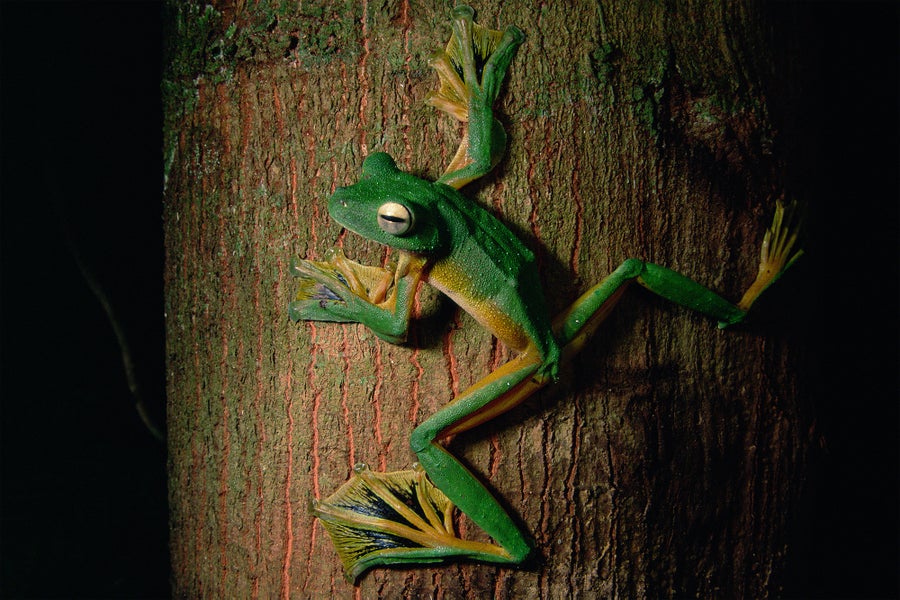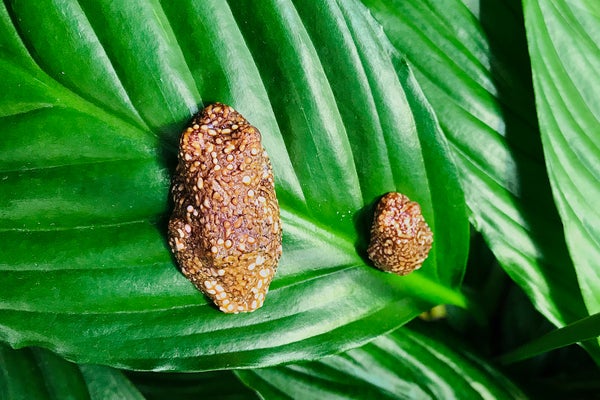Wallace’s flying frog (Rhacophorus nigropalmatus)—a Kermit-green amphibian that would fit in the palm of your hand—spreads its webbed toes to glide gracefully through tropical forest canopies in Borneo, the Malay Peninsula and the Indonesian island of Sumatra. But before it takes to the air, it looks like, well, crap.
That’s because it takes more than a year to develop the black toe webbing that helps the frog soar away from predators. So until they can fly, the froglets (the term for a frog that is no longer a tadpole but isn’t fully grown) of this species hide in plain sight—by camouflaging themselves to look like a blob of poop.
Adult Wallace’s flying frogs are emerald green and blend in with the jungle canopy, but juveniles are an eye-catching reddish orange. This vivid coloration would seem to make them easy pickings for birds. But some scientists have suspected that small white blotches on the froglets’ body are turning the animals from high-contrast targets to objects of revulsion in predators’ eyes; in Southeast Asian jungles, fruit-eating birds and bats leave warm-hued feces with white flecks.
On supporting science journalism
If you're enjoying this article, consider supporting our award-winning journalism by subscribing. By purchasing a subscription you are helping to ensure the future of impactful stories about the discoveries and ideas shaping our world today.
A team of researchers at the University of Vienna set out to determine if this unappetizing disguise really works. For a study published in September in Behavioral Ecology and Sociobiology, scientists painted 640 fake wax froglets in several color schemes: green, like the adults; a bright, uniform red color matching that of the juveniles; and bright red with white speckles, like an actual froglet. Their handiwork was then judged by more than 150 birds in the Vienna Zoo’s Southeast Asian rainforest house.

Wallace's flying frog (Rhacophorus nigropalmatus) on a tree trunk in the lowland rainforest, Danum Valley, Sabah, Borneo. Credit: Nature Picture Library/Alamy Stock Photo
The researchers found that predatory birds targeted the white-spotted models half as often as the pure red ones. “It was surprising that the white spots are such a feature that they don’t get attacked,” says Susanne Stückler, a zoology Ph.D. student at the University of Vienna and co-author of the new paper.
Other species seem to have picked up on the trick as well. Some types of crab spiders and the giant swallowtail caterpillar also sport white spots and are thought to be emulating the pasty-white urea component of bird excrement. This type of camouflage, which imitates an inanimate object, is called a “masquerade.”
David Kikuchi, an assistant professor at Oregon State University who researches animal warning signals, praises Stückler’s study as one of the only “experimental tests of the adaptive value of masquerade.” The greenhouse is a “nice hybrid” between a controlled environment and naturalistic setting, Kikuchi says. “It’s quite successful ... an illustration of how animals probably respond to these things in the wild.”
Wallace’s flying frog is also remarkable in that it uses two very distinct strategies for crypsis—or hiding—over the course of its life, says Doris Preininger, a herpetologist at the Vienna Zoo and co-author of the new paper.
In adulthood the frogs’ strategy is to evade predators’ perception; their camouflage is so sophisticated that they can “dynamically change” the shade of green on different body parts to better match light conditions in the leafy jungle canopy. But as juveniles they purposefully stand out and bank on predators misidentifying them as something distasteful.
But why the sudden switch in crypsis strategies? Little is known about how this species’ froglets spend their time, but researchers assume they live in the forest understory—where droppings from birds and bats are likely to land—whereas adults can keep to the treetops. When organisms alter their appearance in this way to suit a new life stage, it is scientifically known as an ontogenetic color change, Preininger says, but this change generally occurs in the opposite direction: from drab (a camouflage to blend in when a creature is small) to fab (a standout color once its mature defenses are in place).
Hues as bright as those of young Wallace’s flying frogs are usually associated with what are called aposematic signals—the flashing neon “don’t-eat-me” colors of poison dart frogs, monarch butterflies and some cuttlefish—which warn of toxicity.
“It’s amazing that this is a strategy that can be used,” Preininger says, referring to the froglet’s red-poop masquerade. “You can be conspicuous, you’re not toxic, and you’re also not mimicking anything” that is poisonous.
Further study is needed to tease out exactly what makes for a successful poo mimic—perhaps there’s a maximum size for a convincing simulated splat or an ideal ratio of white spots to background color. The researchers were surprised to find that unpainted white frog models, which they intended to use as a control group in the greenhouse study, were attacked least of all. Whether that’s because of novelty or resemblance to feces remains unclear, the authors say.
As to whether just a dash of white is enough to do the trick, Preininger says the answer is clear: if it wasn’t, she says, “we wouldn’t have flying frogs.”
